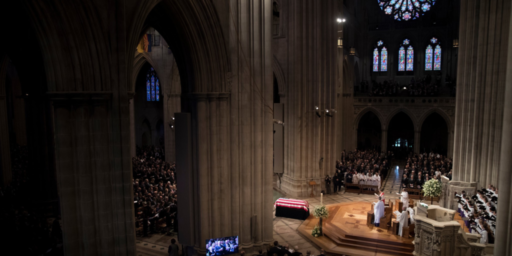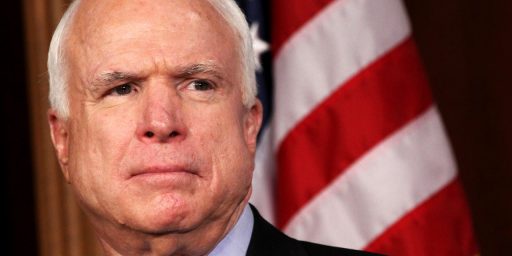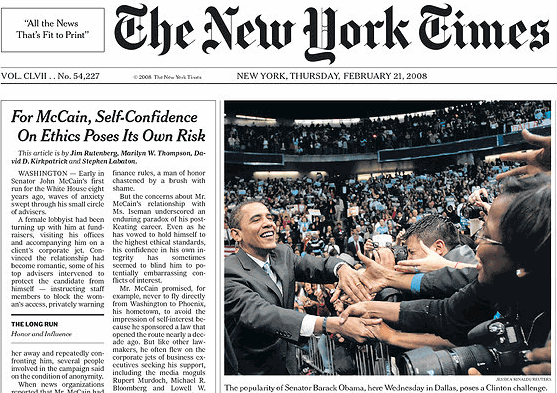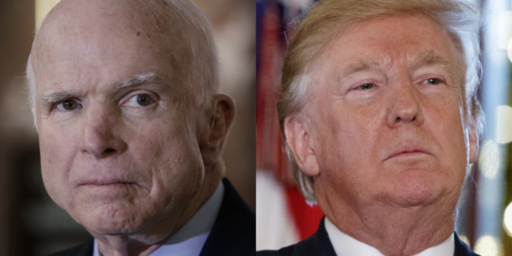Stealth Spending At The Pentagon
The Pentagon is engaging in “stealth spending” [$] according to a report by Eamon Javers in the May 15 Business Week.
The Air Force wants to expand its fleet of F-22 Raptors. But at $130 million apiece, these stealthy planes from Lockheed Martin Corp. are the most expensive fighters ever. So the Pentagon is proposing to buy its next 20 Raptors piecemeal: sections of the fuselage in fiscal 2007, much of the innards in future years.
Senator John McCain (R-Ariz.) smells something funny here. He says the Air Force is trying to minimize the near-term expense of the F-22s while ensuring that eventually Congress will feel obliged to fund all 20 planes. After all, lawmakers don’t want voters to learn that a bunch of half-built fighters are parked in a hangar somewhere. “This approach hamstrings Congress to continue supporting the program, without regard for possible spiraling costs, slips in schedule, or material changes to specifications,” McCain told BusinessWeek in an e-mail interview.
McCain and other budget hawks say they’re seeing more of this kind of gimmickry as the Pentagon strains to maintain the costly occupation of Iraq. A member of the Senate Armed Services Committee, McCain is set to become chairman of the panel next year. In coming days, the once and possibly future Presidential candidate expects to back a slate of acquisition-reform proposals to be introduced by Senator John Warner (R-Va.), the current committee chairman.
The military argues that it’s stretching every dollar to cover a growing list of missions around the world. As for the piecemeal F-22 proposal, now pending before Congress, Air Force spokesman Doug Karas says: “It’s not the run-of-the-mill way to do it. But this is the way, because of budget constraints, that we think we can do it without hurting the program.” Lockheed Martin declined comment.
Buying in pieces isn’t controversial when it comes to huge items such as aircraft carriers, each of which costs billions and takes years to build. Trying to shape the debate on the F-22, McCain asks why the Air Force doesn’t simply ask for the money needed to build the number of planes it wants. The Pentagon has requested $2 billion, rather than the $3.5 billion required for 20 completed fighters.
[…]
The Air Force now acknowledges that it bent the rules. “We said: ‘You know what? You’re right. That should not have been a commercial procurement,”‘ says spokesman Karas. The Air Force was trying to save money and avoid excessive bureaucracy, he adds. Worried about other possible instances of inappropriate “commercial” procurement, Congress demanded in January that the Pentagon provide notice of any supposedly off-the-shelf purchases of major weapon systems.
While I applaud the Air Force’s outside-the-box thinking here and I hate to side with John McCain on general principles, I’m afraid he’s got a point here. On major end items, Congress, not bureaucracies, should decide budget priorities.
Now, whether the Air Force actually needs yet more F-22s is a separate question entirely. . . .





Even though I’m AF, I’ve gotta call shenanigans on my posse here. Major acquisitions (like, as the article says, aircraft carriers) cannot be physically completed in a single fiscal year. But buying piecemeal over several years _just because you can_ is crap. It’s a way of back-dooring a given # of planes end-strength, with no Congressional oversight or questioning of that number. As McCain says, once they buy 20 fuselages and 20 sets of wings, they pretty much _have_ to (at least politically) buy the rest of the planes…